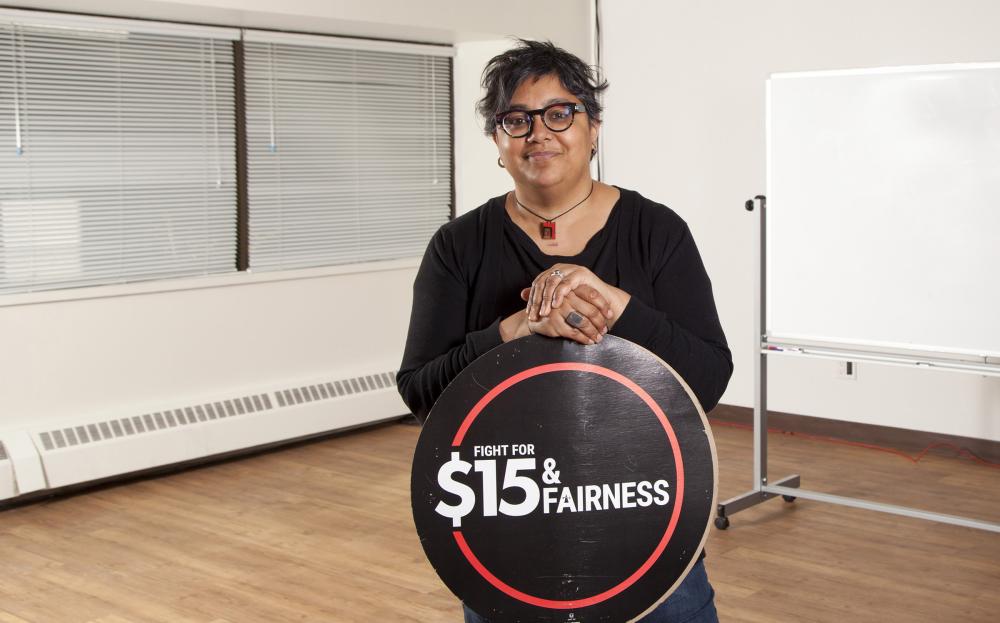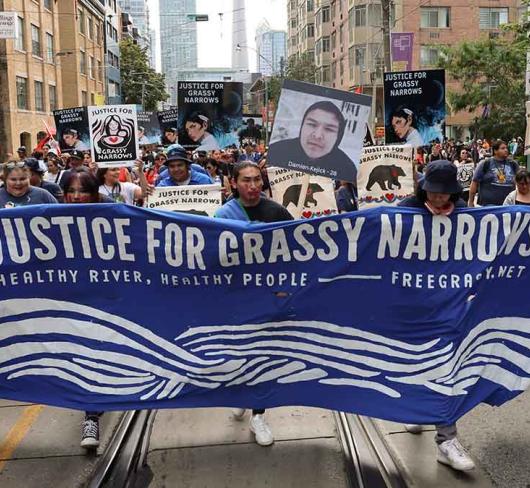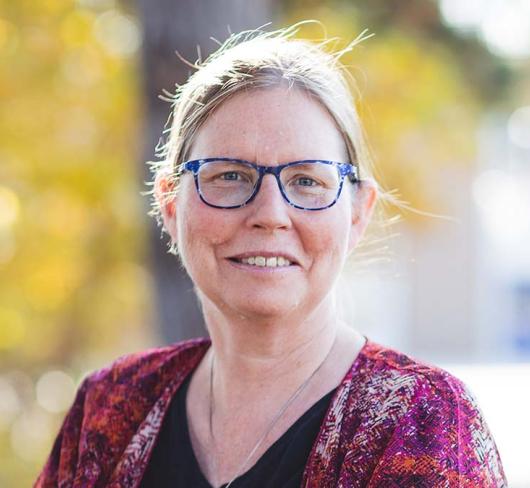
Working Together to Raise Everyone Up: Izida Zorde in Conversation with Workers’ Action Centre Coordinator Deena Ladd.
Izida Zorde: I want to begin by asking you about the Workers’ Action Centre and the organizing that you do.
Deena Ladd: The Workers’ Action Centre is an organization that supports workers who don’t have a union. They could be in temp, contract, part-time or casual types of jobs experiencing violations of their rights or facing discrimination at work. We work with these workers to deal with issues they have in the workplace. But we also do a lot of organizing to improve working conditions systemically across Ontario.
We’re trying to involve workers in the broader labour movement even if they are not connected to any other organization. How can we encourage people not to be victims of wage theft or violations of their rights, but also, through dealing with problems at work, to begin to talk about broader political issues? Why is it that so many workers are facing violations of their rights at work? Why didn’t you get your overtime pay? Why do you feel you will lose your job if you say something about health and safety at work? Through this kind of political discussion we are encouraging people to get involved in the organization, to become members, and then get involved in campaigns, organizing and educating to build a broader labour movement.
IZ: Why is providing the opportunity for people to get politically involved and make changes that have a tangible impact on their lives particularly necessary in light of the rise in precarious work?
DL: Over the last 20 years, we’ve seen a huge increase in precarious work. We’ve seen jobs move from being full-time and permanent with benefits and pensions to being casual, contract, on call, relief, short-term, with no benefits, no pensions and declining wages. In Ontario, about 1.5 million people make less than $15 an hour. That’s a huge low-wage economy. In addition, people lack access to dental care and prescription drugs. Employers are not providing these benefits anymore. We’re seeing workers accessing work through subcontractors, franchisees, brokers and temp agencies. They don’t have a relationship with their employer. Workers are nervous about organizing. People’s expectations about what they should get in a job are being completely crushed. You talk to anyone who’s looking for a job and if they get a six-month contract they think they’ve hit the jackpot. And if they’ve got benefits? Wow, they’re set. Having a decent job, with decent wages and benefits, with an employer who is responsible for your working conditions, is now rare. It’s becoming a myth. That’s a concern to us and should be a concern to everyone.
IZ: How do we fight against lowest common denominator thinking when so many people are facing these types of working conditions?
DL: People are asking “Why do you have a pension? I don’t have a pension. Why do you have benefits? I don’t have benefits – that’s not fair.” Should we be grateful for having any type of job? I think what our organizing has done is change the questions to ask instead, “Why can’t we have benefits? Why can’t we have pensions? Why can’t we have decent jobs? Who is making these decisions and is this inevitable?”
I don’t think it’s only globalization, technology and the restructuring in the labour market that are the determinants here. I think it’s the steps governments have taken to deregulate the labour market and the fact that businesses want workers to accept that precarious work and low wages are inevitable. We see this when our politicians say “Just get used to it. It’s the wave of the future. You’re going to have five or six careers in your lifetime. You should be constantly training. You should be completely flexible. If your employer wants you, you should be right there. And you shouldn’t say anything because you should be grateful you have a job.” What we’ve been trying to do in our organizing is to say “Absolutely not.” We should have expectations of decent work. We should be able to say “If you’re going to pay me, I should be paid over the poverty line. You shouldn’t be paying me to subsist in poverty. And why shouldn’t I have full-time work? Why shouldn’t I have equal pay for equal work? Just because you’ve hired me through a temp agency, why am I being paid 40 percent less?” Pushing people to critically question what’s going on and move beyond that to action is what the Workers’ Action Centre, labour and community groups have been doing.
IZ: Why is it essential that we work to make sure that everyone’s basic needs are met before we ask them to participate in whatever social movement we’re part of?
DL: When we’re doing community organizing and when we’re asking for support for the issues we’re working on, it’s important we understand what power we have and what power the people we’re asking to work with us have. In Ontario, we have a 30 percent unionization rate. The other 70 percent of workers rely on basic employment standards. They have no paid sick days, they have no just cause protection and they cannot speak out if they have a violation of their rights at work without losing their jobs. If these are the people we’re asking to get involved in our campaigns, we need to understand the privilege and the power that we have. If you have benefits, if you have good wages, if you have a collective agreement, if you have a union, if you have a pension, you are part of a very privileged group of workers. When you’re fighting for your own improvements, better collective agreements, better language, it’s going to be hard to get support for those issues because many around you in your community have nothing.
It’s critical that we build alliances between union and non-union workers so we can raise the floor for everyone. If the floor is too low, all our working conditions, our wages, our benefits are going to suffer. This is what we’ve been seeing over the last 20 or 30 years. Fighting concessions is a huge challenge at our collective bargaining tables. If you have a union, you have made very few gains because you’re surrounded by so many people who have nothing and there’s a lot of resentment there. Why should they fight for your 15 paid sick days, for instance, when they have zero? If we don’t understand those connections, if we don’t understand that we have to ensure that everyone has at least the basic floor, that our struggles are connected, we can’t fight for more.
Part of the Fight for $15 and Fairness campaign and part of the work that we’ve been doing at the Workers’ Action Centre has been trying to make those connections, to understand that if we are to build better wages and working conditions, better public education, better health care, stronger community services, stronger public service jobs and better working conditions in the private sector, we need to bring everybody up. We can’t leave anyone behind and that means understanding who is left behind and why they’re being left behind. Racialized and immigrant women are making 54 cents on the dollar made by men compared to white women who are making 72 cents on the dollar. Poor working conditions and poor wages differentially impact workers. We need to make connections with workers who are coming in through the migrant worker program, who are undocumented, who have their status threatened if they speak up about poor working conditions or discrimination.
IZ: Could you tell us about the organizing you did as a parent to support teachers in the last round of bargaining.
DL: Sure. I’m a parent of two girls and I am really interested in the education they’re getting in our public school system. In my daughters’ school, we formed a social justice committee of parents six years ago. We wanted to work with teachers, other parents and our kids to have conversations around issues of social justice. We noticed there was always a Thanksgiving food drive and there were a lot of charitable events organized at the school for international fundraising drives, which was great. But when I talked to my kids and asked them if critical conversations were being had about these charity events, it was clear the children were not talking about why they were trying to collect food for the food hampers for Thanksgiving. Why was it that families in our communities didn’t have enough to eat and relied on food banks when there is so much wealth in Canada? Why do children in Africa need wells for water? What has happened internationally that countries in the south have been depleted of wealth and resources? We felt that those questions were important to ask. We formed a social justice committee as a vehicle to explore and support critical thinking and discussions.
Working conditions, quality education, ensuring that teachers have what they need to do their jobs and that schools have what they need are all part of a social justice agenda. When the contract negotiations were happening between the teachers and the government and Bill 115 was introduced we saw it as part of that agenda. It was very much an issue we were concerned about. Members of our social justice committee asked what we could do to support teachers? What could we do to show the government that we believe in good quality public education, we are concerned about class sizes, we believe teachers should have the professional development, the wages and working conditions they need to do their jobs. It was very natural for us to organize an action at Queen’s Park and reach out to other schools in our neighbourhood and to have some really hard conversations with other parents to get them out to the rally, do leafleting to other parents and talk about the issues. That work has been important because it’s built relationships with teachers in our school.
I think it’s vital that teachers work with parents to create spaces where you can build ongoing relationships, where you’re organizing events that are not necessarily related to traditional forms of solidarity work. Maybe it’s a workshop on diversity. Maybe it’s supporting parents who are concerned about issues of gender and want to make sure there are gender-neutral washrooms in their school. I think anything that supports the building of relationships around common issues and concerns is critical because those issues can be building blocks to having harder conversations around more systemic issues, around how governments make decisions, around cutbacks to public services like education or health care. But you can’t have those conversations on the fly. Those conversations have to be part of a long-term effort and have to be part of relationships you’ve been building for a long time, when you’ve had a chance to get to know each other and work together and talk about other issues people are concerned about.
Our social justice committee has played that role for us. You know, if you get parents connected to your work in the kindergarten years, they’re going to be with you for six or seven years. That’s long-term. For activism and organizing, if you have the potential to recruit someone and get them engaged for the next six years that’s good. I think it’s an important investment to think through how people can come together to have conversations about equity and social justice.
IZ: If you were asked to give a five-step tutorial on how to organize, what would your five steps be?
DL: My five steps for organizing are basic. Number one is to build a strong foundation. If your foundation is weak, your efforts can’t be sustained. Map out who your allies are. Who’s in your school? Who has a voice? Who doesn’t have a voice? Who might share a common agenda? Who are the people you never see at parent council meetings? Who are the people whose kids get bused in from a different district and who will never be a drop-off or pick-up. Who are the allies in the community where children and teachers and parents are interacting, the local business, the local church, the local daycare, the local convenience store where the kids all buy their candy? Those are the people I would be mapping out first and figuring out who I want to reach out to and why.
The next step is working with those folks, working with parents and teachers, to figure out an agenda. Let’s be clear whose agenda it is. It must be a shared agenda anf there must be consensus. If people don’t own it and are not invested in it, why would they come to a meeting and do the work?
My third step would be to use a range of strategies in organizing. Ensure that you don’t use just one way of communicating or one way of doing outreach, but use multiple strategies to involve people and motivate them to take action. It’s not useful to limit people and say the only way to effect change is through letter writing, or the only way is through a petition. We need a range of strategies that can inspire people to get involved. It could be an inspiring film or speaker, but it could also be having a fun action, a pop-up party where the kids get involved and do a lemonade stand, lemonade for equity or to highlight the fact there aren’t enough dollars in the school so you have to resort to a lemonade stand for the education you’re trying to provide. People relate and connect in different ways. We’ve certainly done that in the Fight for $15 and Fairness. We’ve done all kinds of crazy things but the thing is, they should be fun, interesting, engaging and action-oriented. You can do your traditional letter writing, petitions and meetings but also have some fun actions that parents, kids and the broader community can get engaged in.
The next step would be ensuring that you’re achieving what you’ve set out to do and not getting distracted by bureaucracy and different agendas. People want to see change happen. They don’t just want a policy brief that sits on a shelf or endless meetings where you just talk and talk and talk and nothing ever happens. The action piece is critical.
The last step is to make sure you’re building the capacity of everyone who is involved in your committee, that everyone has a chance to be a leader and that you’re building skills, ensuring representation of the diversity of families in your school, getting new people involved. You can’t just have one person who is the shining light. For our work to be sustainable in the long term, the investment we make in ensuring everyone gets a seat at the table and everyone is supported to be at that table is really important.
If you have those five pieces working together you can build a strong foundation because you’ll have the leadership, you’ll have a range of activities, you’ll have a power analysis of who’s at the table, you’ll have mapped out your allies and you’ll have an agenda that everybody’s invested in.
IZ: Any last advice for teachers who are organizing in their communities?
DL: If I was going to give advice to teachers I would say map your schools out and see what strengths you have there. See who should be part of the conversation. Don’t just take the easy route. Reach out to communities and parents whose children have been marginalized, who are facing racism, dealing with issues of poverty, in precarious jobs. They will be your strongest allies because, frankly, they get it. They understand what it means to struggle on a daily basis and they are fighting for their children every single day. But it has to be a partnership. It cannot be a one-way street. When you are going out and talking to people about public education, you also need to be ask them “What are you concerned about? What is the thing that keeps you up at night? What are your fears for your children? Are you afraid of the fact that you’re going to have to move from your apartment because you can’t pay your rent or because there are cockroaches or you don’t feel safe on the streets?” What are the issues that parent is concerned with and what are you going to do to support them in their community, in their neighbourhood and in their home? If they don’t see that it’s a two-way street and they don’t see that you care about what their issues are, why should they care about your issues even though their child is in your classroom?
You have to reach out, do a lot of listening, try to make the linkages with what people are experiencing in their community and understand the points of connection between what you are fighting for as a teacher and what they are fighting for. If we don’t understand what that common agenda is and how we can work together, we’re not going to move this discussion forward.

